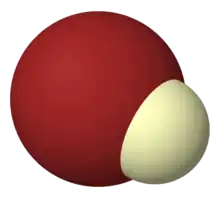Deuterium bromide
Deuterium bromide is hydrogen bromide with the hydrogen being the heavier isotope deuterium. Hydrogen represents only a small fraction of the mass so it is not significantly heavier than typical hydrogen bromide.
 | |
| Names | |
|---|---|
| IUPAC name
(2H)bromane | |
Other names
| |
| Identifiers | |
3D model (JSmol) |
|
| ChemSpider | |
| EC Number |
|
PubChem CID |
|
| |
| |
| Properties | |
| DBr | |
| Molar mass | 81.92 g mol−1 |
| Appearance | Colourless or slightly yellow liquid |
| Density | 1.537 g mL−1 |
| Melting point | −87 °C (−125 °F; 186 K) [2] |
| Boiling point | 126 °C (259 °F; 399 K) [2] |
| Yes | |
| log P | 0.85 |
| Hazards[2] | |
| GHS labelling: | |
| Danger | |
| NFPA 704 (fire diamond) | |
| Flash point | 126 °C (259 °F; 399 K) |
Except where otherwise noted, data are given for materials in their standard state (at 25 °C [77 °F], 100 kPa).
Infobox references | |
See also
- Hydrogen bromide
- Heavy water (Water with deuterium in place of normal hydrogens.)
References
- "Hydrobromic acid-d". CAS Common Chemistry. Retrieved 23 August 2022.
- "DEUTERIUM BROMIDE". Chemical Book. Retrieved 23 August 2022.
This article is issued from Wikipedia. The text is licensed under Creative Commons - Attribution - Sharealike. Additional terms may apply for the media files.
